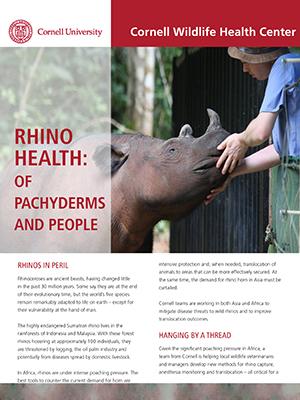Rhinos in Indonesia
Protecting critically endangered rhinos
From disease threats in Ujung Kulon National Park to efforts to safely unite isolated Sumatran rhinos for better breeding and care, health is at the heart of the survival of these critically endangered Indonesian rhinos.
Health Matters
Perhaps fewer than 50 Javan rhinos remain on the planet—confined to one population in Indonesia. In such a small group, health matters. Tsunamis, sea level rise, climate change, and human activities all threaten the Javan rhino. In addition, in Ujung Kulon National Park, where the last Javan rhinos live, local domesticated water buffalo carry dangerous blood parasites and a range of other potential pathogens. We are evaluating whether these infectious diseases may pose a threat to these critically endangered rhinos.
Rhino Health Unit
The highly endangered Sumatran rhino lives in the rainforests of Indonesia. With these forest rhinos hovering at approximately 100 individuals, they are threatened by logging, the oil palm industry and potentially from diseases spread by domestic livestock.
Scientists in Indonesia have taken action – they’ve started a Rhino Health Unit, the first of its kind in their country and perhaps the world. We offer essential guidance to the Unit by facilitating research, providing technical support, and training a new generation of young professionals ready to lead Indonesian rhinoceros conservation at a critical juncture. A second home for the Javan rhinos is being developed outside Ujung Kulon, and a plan is underway to safely capture remaining, isolated Sumatran rhinos to bring them together to enhance prospects for better breeding and protection.




